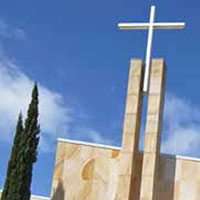 The Art and Architecture Committee of Sacred Heart Parish, Sandringham.
The Art and Architecture Committee of Sacred Heart Parish, Sandringham.
Sandringham parish is in the Archdiocese of Melbourne. Rev Dr Frank O’Loughlin was parish priest for over two decades (1996-2020). During that time the fabric of the 1974 church building has been transformed and the church has been enriched with beautiful new art, while carefully preserving the stained glass heritage from the first church opened in 1906. Continue reading “Working Together”

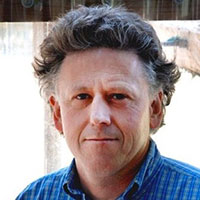 The Power of Touch
The Power of Touch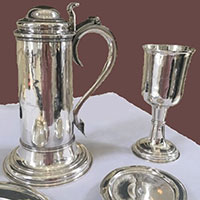 Rite and Vessels
Rite and Vessels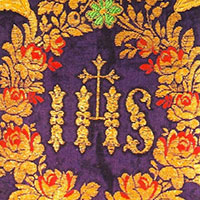 My PhD research project at the University of Canberra, Treasured Threads: Ecclesiastical Textiles as Living Heritage of the Catholic Church in Australia (2019), grew out of my BA (Hons) dissertation which was inspired by three fragments of historical ecclesiastical embroidery salvaged from old, worn and damaged vestments made obsolete following the reforms of the Second Vatican Council. Vatican II reduced the number and type of ecclesiastical garments worn by clerics and simplified vestment design. As a result, a large amount of ecclesiastical textile heritage was removed from service. Visiting heritage textile collections and speaking with custodians has uncovered a diverse and unexpected web of community and personal significance and values that connect this living textile heritage to a broader web of local, national and international history and ongoing cultural life.
My PhD research project at the University of Canberra, Treasured Threads: Ecclesiastical Textiles as Living Heritage of the Catholic Church in Australia (2019), grew out of my BA (Hons) dissertation which was inspired by three fragments of historical ecclesiastical embroidery salvaged from old, worn and damaged vestments made obsolete following the reforms of the Second Vatican Council. Vatican II reduced the number and type of ecclesiastical garments worn by clerics and simplified vestment design. As a result, a large amount of ecclesiastical textile heritage was removed from service. Visiting heritage textile collections and speaking with custodians has uncovered a diverse and unexpected web of community and personal significance and values that connect this living textile heritage to a broader web of local, national and international history and ongoing cultural life. 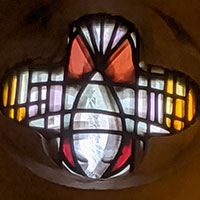 In the same way that churches have been built by Christians for two millennia, the small stone church in the Sydney suburb of Pyrmont, dedicated to St Bede the Venerable, was built by the hands of its parishioners. Much of the sandstone used to build the early buildings of Sydney was quarried in Pyrmont, the same stone that the parishioners cut from the site, shaped and laid to build St Bede’s. They completed the building in 1867 providing for a congregation of about 120 to gather for Mass.
In the same way that churches have been built by Christians for two millennia, the small stone church in the Sydney suburb of Pyrmont, dedicated to St Bede the Venerable, was built by the hands of its parishioners. Much of the sandstone used to build the early buildings of Sydney was quarried in Pyrmont, the same stone that the parishioners cut from the site, shaped and laid to build St Bede’s. They completed the building in 1867 providing for a congregation of about 120 to gather for Mass. 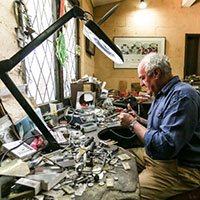 St Francis’ Church, Lonsdsale St, Melbourne
St Francis’ Church, Lonsdsale St, Melbourne Victorian sculptor Ernst Fries is known for his monumental works in stainless steel and granite, glass and concrete. He was born in Würzburg, Germany, and after a difficult childhood during World War II, studied gold and silver-smithing in Switzerland. He came to Australia in 1959. He settled in the Yarra Valley in 1986 where the landscape inspired him to explore themes of rebirth and new life in the elegant clean lines of his modern sculpture. With work in gallery collections in Australia and overseas, he has received many commissions for public sculpture, for example, in 2013, the glass and concrete panels of the Yarra Glen Black Saturday Memorial.
Victorian sculptor Ernst Fries is known for his monumental works in stainless steel and granite, glass and concrete. He was born in Würzburg, Germany, and after a difficult childhood during World War II, studied gold and silver-smithing in Switzerland. He came to Australia in 1959. He settled in the Yarra Valley in 1986 where the landscape inspired him to explore themes of rebirth and new life in the elegant clean lines of his modern sculpture. With work in gallery collections in Australia and overseas, he has received many commissions for public sculpture, for example, in 2013, the glass and concrete panels of the Yarra Glen Black Saturday Memorial.  St Francis of Assisi, Mill Park, VIC
St Francis of Assisi, Mill Park, VIC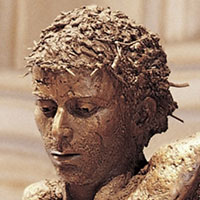 The Cathedral of St Stephen in Brisbane holds the best collection of the work of Australian sculptor, John Elliott (1943-2016). Nowhere else are there three major works together. The cathedral has the shrine of Virgin Mary, the altar crucifix and the diocesan shrine of patron St Mary MacKillop. John Elliott was born in Canterbury, England, studied at the Royal College of Art in London, and migrated to Australia in 1970. He taught sculpture at the Queensland College of Art.
The Cathedral of St Stephen in Brisbane holds the best collection of the work of Australian sculptor, John Elliott (1943-2016). Nowhere else are there three major works together. The cathedral has the shrine of Virgin Mary, the altar crucifix and the diocesan shrine of patron St Mary MacKillop. John Elliott was born in Canterbury, England, studied at the Royal College of Art in London, and migrated to Australia in 1970. He taught sculpture at the Queensland College of Art. 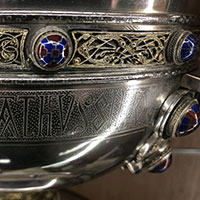 The Ardagh Chalice is a superb and ornate example of early medieval Irish liturgical metalwork, dating from around the 9th century.
The Ardagh Chalice is a superb and ornate example of early medieval Irish liturgical metalwork, dating from around the 9th century.